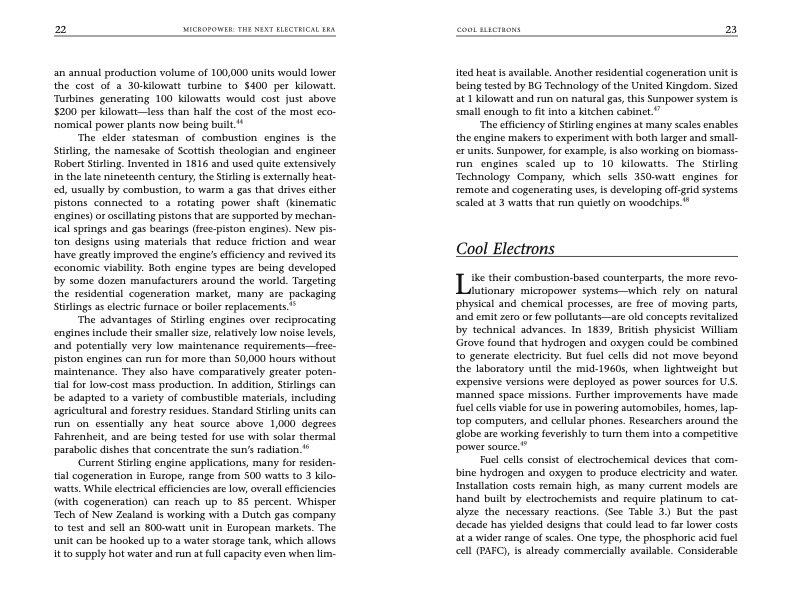
PDF Publication Title:
Text from PDF Page: 012
22 MICROPOWER: THE NEXT ELECTRICAL ERA COOL ELECTRONS 23 an annual production volume of 100,000 units would lower the cost of a 30-kilowatt turbine to $400 per kilowatt. Turbines generating 100 kilowatts would cost just above $200 per kilowatt—less than half the cost of the most eco- nomical power plants now being built.44 The elder statesman of combustion engines is the Stirling, the namesake of Scottish theologian and engineer Robert Stirling. Invented in 1816 and used quite extensively in the late nineteenth century, the Stirling is externally heat- ed, usually by combustion, to warm a gas that drives either pistons connected to a rotating power shaft (kinematic engines) or oscillating pistons that are supported by mechan- ical springs and gas bearings (free-piston engines). New pis- ton designs using materials that reduce friction and wear have greatly improved the engine’s efficiency and revived its economic viability. Both engine types are being developed by some dozen manufacturers around the world. Targeting the residential cogeneration market, many are packaging Stirlings as electric furnace or boiler replacements.45 The advantages of Stirling engines over reciprocating engines include their smaller size, relatively low noise levels, and potentially very low maintenance requirements—free- piston engines can run for more than 50,000 hours without maintenance. They also have comparatively greater poten- tial for low-cost mass production. In addition, Stirlings can be adapted to a variety of combustible materials, including agricultural and forestry residues. Standard Stirling units can run on essentially any heat source above 1,000 degrees Fahrenheit, and are being tested for use with solar thermal parabolic dishes that concentrate the sun’s radiation.46 Current Stirling engine applications, many for residen- tial cogeneration in Europe, range from 500 watts to 3 kilo- watts. While electrical efficiencies are low, overall efficiencies (with cogeneration) can reach up to 85 percent. Whisper Tech of New Zealand is working with a Dutch gas company to test and sell an 800-watt unit in European markets. The unit can be hooked up to a water storage tank, which allows it to supply hot water and run at full capacity even when lim- ited heat is available. Another residential cogeneration unit is being tested by BG Technology of the United Kingdom. Sized at 1 kilowatt and run on natural gas, this Sunpower system is small enough to fit into a kitchen cabinet.47 The efficiency of Stirling engines at many scales enables the engine makers to experiment with both larger and small- er units. Sunpower, for example, is also working on biomass- run engines scaled up to 10 kilowatts. The Stirling Technology Company, which sells 350-watt engines for remote and cogenerating uses, is developing off-grid systems scaled at 3 watts that run quietly on woodchips.48 Cool Electrons Like their combustion-based counterparts, the more revo- lutionary micropower systems—which rely on natural physical and chemical processes, are free of moving parts, and emit zero or few pollutants—are old concepts revitalized by technical advances. In 1839, British physicist William Grove found that hydrogen and oxygen could be combined to generate electricity. But fuel cells did not move beyond the laboratory until the mid-1960s, when lightweight but expensive versions were deployed as power sources for U.S. manned space missions. Further improvements have made fuel cells viable for use in powering automobiles, homes, lap- top computers, and cellular phones. Researchers around the globe are working feverishly to turn them into a competitive power source.49 Fuel cells consist of electrochemical devices that com- bine hydrogen and oxygen to produce electricity and water. Installation costs remain high, as many current models are hand built by electrochemists and require platinum to cat- alyze the necessary reactions. (See Table 3.) But the past decade has yielded designs that could lead to far lower costs at a wider range of scales. One type, the phosphoric acid fuel cell (PAFC), is already commercially available. ConsiderablePDF Image | Micropower: The Next Electrical Era

PDF Search Title:
Micropower: The Next Electrical EraOriginal File Name Searched:
EWP151.pdfDIY PDF Search: Google It | Yahoo | Bing
Capstone Turbine and Microturbine: Capstone microturbines used and new surplus for sale listing More Info
Consulting and Strategy Services: Need help with Capstone Turbine, sizing systems, applications, or renewable energy strategy, we are here to assist More Info
Container Lumber Dry Kiln: Since 1991 developing and innovating dry kilns using standard shipping containers More Info
Supercritical CO2 Lumber Dry Kiln: Compact fast drying in 3 days or less for small amounts of wood and lumber drying More Info
BitCoin Mining: Bitcoin Mining and Cryptocurrency... More Info
Publications: Capstone Turbine publications for microturbine and distributed energy More Info
FileMaker Software for Renewable Energy Developing database software for the renewable energy industry More Info
CO2 Gas to Liquids On-Demand Production Cart Developing a supercritical CO2 to alcohol on-demand production system (via Nafion reverse fuel cell) More Info
Stranded Gas for low cost power Bitcoin Mining Using stranded gas for generators may provide breakthrough low power costs for cryptocurrency miners. More Info
| CONTACT TEL: 608-238-6001 Email: greg@globalmicroturbine.com | RSS | AMP |